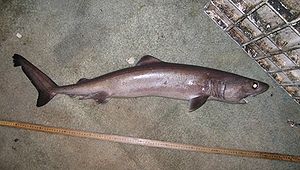Crocodile shark
| Crocodile shark | ||||||||||||
|---|---|---|---|---|---|---|---|---|---|---|---|---|

Crocodile shark ( Pseudocarcharias kamoharai ) |
||||||||||||
| Systematics | ||||||||||||
|
||||||||||||
| Scientific name of the family | ||||||||||||
| Pseudocarchariidae | ||||||||||||
| Compagno , 1973 | ||||||||||||
| Scientific name of the genus | ||||||||||||
| Pseudocarcharias | ||||||||||||
| Cadenat , 1963 | ||||||||||||
| Scientific name of the species | ||||||||||||
| Pseudocarcharias kamoharai | ||||||||||||
| ( Matsubara , 1936) |
The crocodile shark ( Pseudocarcharias kamoharai ) is the only species from the shark family Pseudocarchariidae and is one of the smaller shark species with a length of about 70 to 110 centimeters. It was first described by Kiyomatsu Matsubara in 1936 . Its systematic classification was controversial for some time. Likewise, little is known about his way of life.
features
The crocodile shark is a small spindle-shaped shark with large eyes, a long, conically pointed snout, sliding jaws and long gill slits. It has a gray-brown body color with a light belly, lateral caudal keels, small thornless dorsal fins and a short asymmetrical caudal fin. The length of fully grown specimens is around 70 to a maximum of 110 centimeters, the mass around four to six kilograms. Its teeth are blunt compared to other shark species and are more suitable for snapping small prey than for tearing chunks of food out of larger animals.
Due to the large eyes, it can be assumed that it is predominantly nocturnal. There are indications that it is mainly near the surface of the water at night and in greater water depths during the day. So far, no attacks on people have come to light. Because of this and because of its small size, its relatively harmless dentition and its oceanic habitat, it is considered harmless to humans.
Way of life
distribution and habitat
Its habitat is predominantly on continental slopes up to a depth of approx. 300–600 meters in the eastern Atlantic , in the western Indian Ocean , in the western North Pacific and in the central eastern Pacific, often near islands such as B. Cape Verde , Madagascar , Japan or Hawaii .
Reproduction and nutrition
The crocodile shark reproduces viviparous eggs ( ovoviviparia ), that is, the eggs are hatched in the womb and the young hatch in the womb. He usually gets four young animals (two per uterus), which reach a birth size of approx. 40 cm. Its diet consists mainly of bony fish , octopus and crustaceans .
Little is known about other aspects of its way of life, as it is rare according to the current state of knowledge and only a few specimens have been caught or found since its first description. Most of the catches so far have come from Japanese fishermen and deep-sea anglers.
Worth mentioning
An expedition commissioned by the US telephone company AT&T in the late 1980s, based on an investigation into bite marks, found that most of the damage to deep-sea telephone cables caused by shark bites was caused by crocodile sharks . The reasons for this could not be conclusively clarified, as crocodile sharks normally do not look for food on the sea floor according to the current state of knowledge. In addition, during this expedition not a single crocodile shark was caught in attempts to catch it near deep-sea cables.
literature
- K. Matsubara: A new carcharoid shark found in Japan. In: Zoological Magazine, Tokyo (Dobutsugaku Zasshi). 48 (7 )/1936. The Zoological Society of Japan, pp. 380-382, ISSN 0044-5118
- EV Romanov, VV Samorov: On discoveries of the crocodile shark, Pseudocarcharias kamoharai (Pseudocarchariidae), in the Equatorial Indian Ocean. In: Journal of Ichthyology (Voprosy Ikhtiologii). 34 (4 )/1994. Maik Nauka / Interperiodica, pp. 155-157, ISSN 0032-9452
- DJ Long, JA Seigel: A crocodile shark, Pseudocarcharias kamoharai, (Selachii: Lamnidae) from pelagic waters off Baja California, Mexico. In: Oceanides. 12 (1 )/1997. Centro Interdisciplinario de Ciencias Marinas - Instituto Politécnico Nacional, pp. 61–63, ISSN 1560-8433
- AL Stewart: First record of the crocodile shark, Pseudocarcharias kamoharai (Chondrichthyes: Lamniformes), from New Zealand waters. In: New Zealand Journal of Marine and Freshwater Research. 35/2001. The Royal Society of New Zealand, pp. 1001–1006, ISSN 0028-8330 ( PDF version available online )
Web links
- Crocodile Shark on Fishbase.org (English)
- Pseudocarcharias kamoharai inthe IUCN Red List of Endangered Species 2013.1. Posted by: Compagno, LJV & Musick, JA, 2005. Retrieved November 6, 2013.
- Interactive shark family tree: crocodile shark (Pseudocarcharias kamoharai)
- Crocodile Shark | Pseudocarcharias kamoharai (English, with pictures)
- lamna.net - Crocodile Shark Pseudocarcharias kamoharai (engl.)
- Biology of the Crocodile Shark (Engl.)
